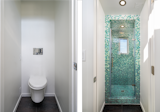Joshua Tree E Cabin
Details
Credits
From Justin Slade
A challenge for building smaller- how small can you go and not feel like living in a trailer. This is an endeavor E Ficient has taken on with their project, Joshua Tree E Cabin (E for efficient). At only 384 sq ft, 12 ft wide and 32 ft long, the one bedroom home is very small, but not so “tiny”. The house pushes the limits between minimal living and maintaining amenities homeowners might have a hard time living without. The great room allows a full size kitchen, plenty of room to cook and eat, while also leaving plenty of room to lounge and entertain- no furniture moving is required. The full-size bathroom is more functional than most, boasting two vanities, a separate toilet room, and separate shower room. Built-in cabinets throughout allow for ample storage. The large window in the great room allows light to fill the space, provides dramatic views, and makes the space feel much larger. The biggest overall take- E Cabin feels like a home, not a trailer. Although the owner of E Cabin uses the house as a weekend retreat, the floor plan is functional and spacious enough for daily living.
Justin Slade of E Ficient- “Not only do we want to offer appealing small houses for our homebuyers, but hopefully inspire other real estate developers to build smaller. Sometimes creating a small environmental footprint, literally means a small footprint. A small house takes up less real estate and has less impact on natural resources. A small house is also more energy efficient, requiring less energy to heat, cool, and maintain.
Another benefit of building small is that it is more conducive to prefab construction. Prefab shifts most of the building process to a factory, which is a more sustainable method for building: requires less energy and a more efficient use of building materials.
Smaller spaces also allow the opportunity to build with materials which otherwise might be cost-prohibitive. When a living room is only 150 sq ft instead of 400 sq ft, a homeowner may justify reclaimed wood on a wall or a flooring material that will last longer. The burned redwood cladding or shou sugi ban on the exterior of E Cabin, protects the wood from the desert sun and the gaps between the cladding allow warm air to escape. A large house may not justify the extra cost of wood cladding."








